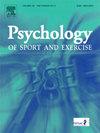在基于经验和概念知识的干预措施中加入规划策略:它有助于减少久坐时间吗?
IF 3.3
2区 心理学
Q2 HOSPITALITY, LEISURE, SPORT & TOURISM
引用次数: 0
摘要
研究目的本研究比较了 "积极 "对照条件与干预条件的效果,前者涉及有关行为的概念和经验知识,而后者则将概念和经验知识与行动规划、应对计划和行为替代相结合。我们将减少久坐时间作为主要结果:我们对 603 名年龄在 11-86 岁之间的参与者(男 = 33.57;65.2% 为女性)进行了预先登记的试验[BLINDED],他们被随机分配到 "计划 + 知识 "条件或 "知识 "条件下。分别在基线、1周和36周的随访中使用ActiGraph wGT3X-BT加速度计对静坐时间进行评估。概念性知识策略包括有关健康后果的信息和行为指导,而体验性知识则通过参与者拍摄/讨论引发久坐行为的家庭环境照片来加强。行动/应对计划指的是用体育锻炼行为替代久坐行为的方法。结果显示,时间与条件之间没有显著的交互作用:结果:没有发现明显的时间 × 条件交互作用。在所有样本中,基线时的久坐时间估计约为 502.34 分钟/天,随着时间的推移出现了明显的线性下降(p = .002),自基线起每月下降约-1.22 分钟(8 个月内为-9.76 分钟/天):研究结果表明,应用行为改变技术,针对久坐行为的前因、环境和后果的概念性和经验性知识,可能会使久坐时间略有减少。增加行动计划、应对规划和行为替代并未提高干预效果。本文章由计算机程序翻译,如有差异,请以英文原文为准。
Adding planning strategies to an experiential and conceptual knowledge-based intervention: Does it help to reduce sedentary time?
Objective
The study compared the effects of an “active” control condition addressing conceptual and experiential knowledge about sedentary behavior, with an intervention condition combining conceptual and experiential knowledge together with action planning, coping planning, and behavioral substitution. We targeted a decrease in sedentary time as the primary outcome.
Methods
A preregistered trial (#NCT04131270) was carried out with 603 participants aged 11–86 years (M = 33.57; 65.2% women), randomly assigned to the “planning + knowledge” condition or the “knowledge” condition. Sedentary time was assessed with ActiGraph wGT3X-BT accelerometers at baseline, 1-week, and 36-week follow-ups. Conceptual knowledge strategies involved information about health consequences and instructions on how to perform behaviors while experiential knowledge was enhanced by participants taking/discussing photographs of their home environment that has been triggering sedentary behavior. Action/coping plans referred to ways to substitute sedentary behavior with bouts of physical activity behaviors. Mixed models were fit.
Results
No significant Time × Condition interaction was found. In the total sample, sedentary time estimated to be around 502.34 min/day at baseline, showed a significant linear decline over time (p = .002), by approximately −1.22 min per each month elapsing since baseline (−9.76 min/day across 8 months).
Conclusions
The findings suggest that applying behavior change techniques targeting both conceptual and experiential knowledge about antecedents, circumstances, and consequences of sedentary behavior may result in a small reduction of sedentary time. Adding action plans, coping planning, and behavioral substitution did not improve the effectiveness of the intervention.
求助全文
通过发布文献求助,成功后即可免费获取论文全文。
去求助
来源期刊
CiteScore
6.40
自引率
5.90%
发文量
172
审稿时长
69 days
期刊介绍:
Psychology of Sport and Exercise is an international forum for scholarly reports in the psychology of sport and exercise, broadly defined. The journal is open to the use of diverse methodological approaches. Manuscripts that will be considered for publication will present results from high quality empirical research, systematic reviews, meta-analyses, commentaries concerning already published PSE papers or topics of general interest for PSE readers, protocol papers for trials, and reports of professional practice (which will need to demonstrate academic rigour and go beyond mere description). The CONSORT guidelines consort-statement need to be followed for protocol papers for trials; authors should present a flow diagramme and attach with their cover letter the CONSORT checklist. For meta-analysis, the PRISMA prisma-statement guidelines should be followed; authors should present a flow diagramme and attach with their cover letter the PRISMA checklist. For systematic reviews it is recommended that the PRISMA guidelines are followed, although it is not compulsory. Authors interested in submitting replications of published studies need to contact the Editors-in-Chief before they start their replication. We are not interested in manuscripts that aim to test the psychometric properties of an existing scale from English to another language, unless new validation methods are used which address previously unanswered research questions.

 求助内容:
求助内容: 应助结果提醒方式:
应助结果提醒方式:


